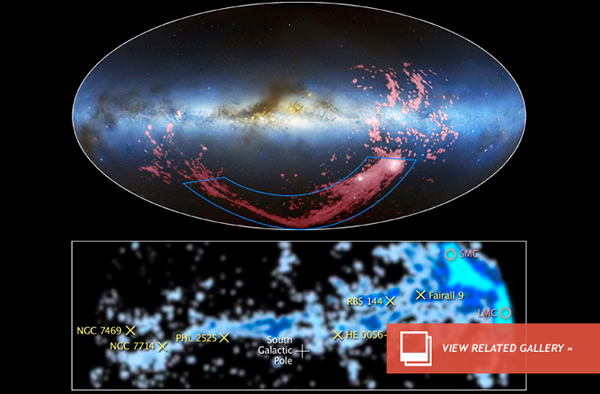Kaboom! Milky Way's Black Hole Erupted 2 Million Years Ago
Kaboom! Milky Way's Black Hole Erupted 2 Million Years Ago
The supermassive black hole hiding in the center of our galaxy last erupted two million years ago. This conclusion was reached by astronomers who carried out a kind of cosmic archaeological hunt.
Gargantuan black holes are thought to exist in the center of the majority of galaxies. In fact, these spacetime-warping behemoths are thought to be key in the evolution of galaxies; they consume vast quantities of stellar material, eject powerful streams of energy, and have the power to switch on and even extinguish star formation in their host galaxies.
The Milky Way’s supermassive black hole is located in the dense galactic hub, approximately 25,000 light-years from our solar system, generating a characteristic radio wave emission known as Sagittarius A* (Sgr A*). It has a mass of four million suns, a number that was deduced by astronomers observing the nearby stars scoot around on helter-skelter-like orbits in the galactic core.
Currently, Sgr A* is quiet, enjoying a vacation from its rocking years as an active black hole when it ate gas, dust and any unfortunate stars that strayed within its gravitational grasp. Nowadays, the occasional object gets too close and are rapidly converted into an energetic soup, blasting small bursts of X-rays, but on the most part Sgr A* is quiescent.
Curious as to when our supermassive black hole last erupted, a team of astronomers led by Joss Bland-Hawthorn, of the University of Sydney, Australia, decided to look into the nature of a mysterious galactic artifact that may be evidence for the black hole’s most recent cosmic eruption.
“For twenty years we’ve seen this odd glow from the Magellanic Stream,” said Bland-Hawthorn in a press release. “We didn’t understand the cause. Then suddenly we realized it must be the mark, the fossil record, of a huge outburst of energy from the center of our galaxy.”
The Magellanic Stream is a glowing filament of mostly hydrogen gas that trails away from the Milky Way’s two companion galaxies, the Large and Small Magellanic Clouds (pictured top). By Bland-Hawthorn’s reckoning, the glowing gas could be a cosmic record of a violent galactic eruption some two million years ago.
Ultraviolet radiation from the black hole eruption energized the Magellanic Stream’s hydrogen gas (by splitting apart the protons and electrons in the hydrogen atoms), causing it to generate its own specific type of radiation (when the protons and electrons recombined). The amount of H-alpha emissions, the distance the brightest radiating portions of the Stream is from the galactic core and the rate at which the Stream would have cooled over time “all fits together, it all adds up,” said Greg Madsen, of the University of Cambridge and co-investigator for the study.
There are other corroborating signs that our supermassive black hole erupted in the recent cosmic past. Infrared and X-ray observatories have detected an energetic outflow from the galactic center and gamma-ray radiation from two huge lobes above and below the galactic plane — known as “Fermi bubbles” — suggest something energetic has occurred.
“All this points to a huge explosion at the center of our galaxy,” added team member Philip Maloney of the University of Colorado in Boulder. “What astronomers call a Seyfert flare.”
So the last big flare was likely 2 million years ago, when will the next one happen?
“There are lots of stars and gas clouds that could fall onto the hot disk around the black hole,” said Bland-Hawthorn. “There’s a gas cloud called G2 that we think will fall in next year. It’s small, but we’re looking forward to the fireworks!”
This research has been accepted for publication in The Astrophysical Journal and Bland-Hawthorn will discuss this recent discovery at the Galaxy Zoo meeting in Sydney, Australia, on Sept. 24.
Image: These images show wide and close-up views of a long ribbon of gas called the Magellanic Stream, which stretches nearly halfway around the Milky Way. Credit for the radio/visible light image: David L. Nidever, et al., NRAO/AUI/NSF and Mellinger, LAB Survey, Parkes Observatory, Westerbork Observatory, and Arecibo Observatory. Credit for the radio image: LAB Survey(Sep 23, 2013 04:17 PM ET // by Ian O'Neill)












